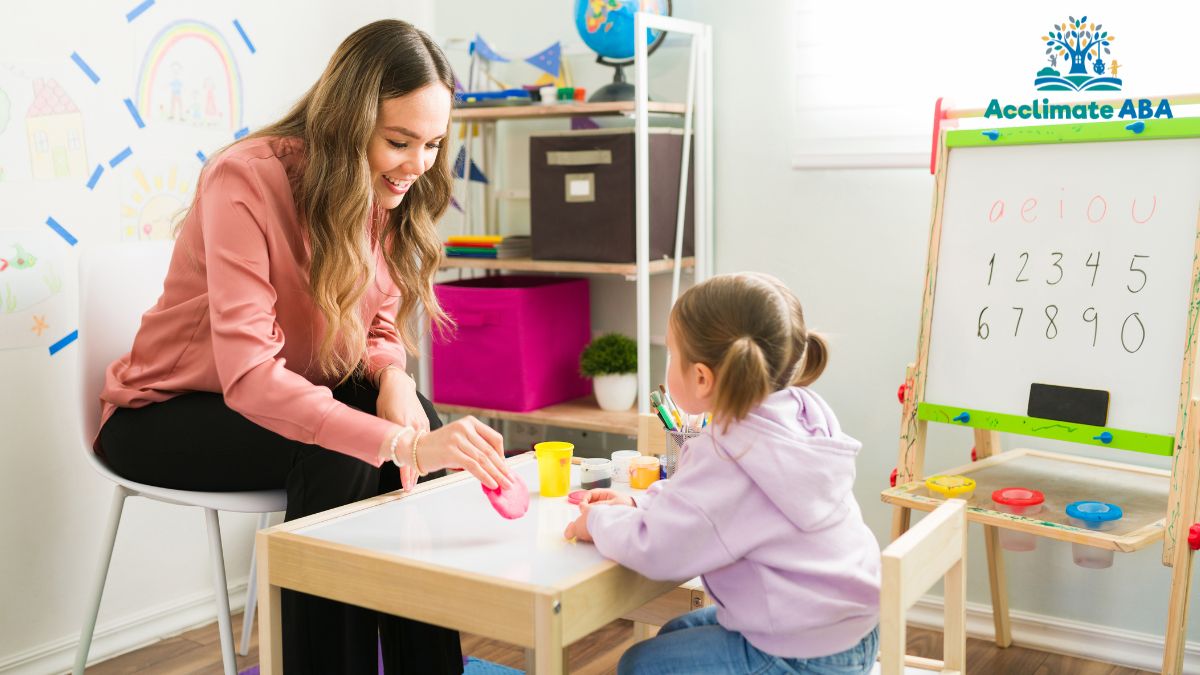Key Points:
- The most costly ABA mistakes parents make include delaying evaluation, setting vague goals, skipping coaching, and choosing low-quality or misaligned providers.
- These errors delay progress, limit funding options, and reduce long-term impact.
- Early action, clear goals, and active parent involvement protect both time and therapy outcomes.
Daily life feels heavy when mealtimes, toileting, or transitions keep breaking down. Applied Behavior Analysis (ABA) offers a structured way to teach skills, yet families lose time and money when common errors creep in.
Below, we’ll explain which choices drain budgets the most and how to avoid them. Expect practical steps to avoid the common ABA mistakes parents commit, sample questions, and research-backed tips you can use at home.
 Are Parents Delaying Evaluation Too Long?
Are Parents Delaying Evaluation Too Long?
Many families wait for school feedback or a pediatrician referral before seeking formal assessment. Waiting pushes back intervention, reduces insurance options, and limits the available time for early learning.
Autism now affects about 1 in 31 eight-year-olds, which means screening resources fill up fast and waitlists grow. Early screening and referral help secure services during the most teachable years.
Avoid the delay with these steps:
- Ask your pediatrician for an immediate developmental screening after concerns show up in language, play, or social response.
- Request a full diagnostic evaluation list from your insurer and join multiple waitlists at once.
- Schedule hearing and vision checks to rule out simple causes that can slow language and attention.
Are Goals Too Broad To Measure?
“Improve behavior” sounds helpful, yet broad targets stall progress and hide whether therapy works. Clear goals move faster because everyone knows the skill, trigger, prompt, and success measure. Therapists write strong goals, but parents shape them by naming the daily moments that need change.
Write sharper goals with these moves:
- Pinpoint the routine: “brush teeth for two minutes,” “sit for dinner for five minutes,” “ask for a break before leaving the table.”
- Anchor the start point: note current duration, prompts, or protests so growth becomes visible.
- Tie goals to home and school: agree on the same cue words, visuals, and rewards across settings.
 Are Sessions High Intensity But Low Quality?
Are Sessions High Intensity But Low Quality?
Some families push for more hours before checking delivery quality. Intensity helps only when the program teaches usable skills across people and places, using approaches like modeling in ABA. More hours at the table without generalization wastes effort and budget.
Upgrade quality before adding hours:
- Review teaching plans weekly: what skill, what cue, what prompt, what fade plan, and what success data.
- Watch sessions in different places: kitchen, bathroom, playground, grocery store.
- Expect a generalization plan: new people, new materials, and varied prompts so skills transfer.
Are Parents Missing Coaching Opportunities?
Parent-implemented strategies amplify gains because practice happens during real routines, and simple tips for autism caregivers keep home practice consistent.
One meta-analysis reported moderate benefits for children when caregivers learn and deliver strategies, with overall effects around half a standard deviation. That scale of change compounds across weeks and saves therapy time.
Make coaching pay off:
- Attend short, regular coaching blocks and ask for one new strategy per week.
- Practice one step at a time: model, prompt, fade, celebrate.
- Track one number: requests per hour, successful transitions, or minutes on task.
Are Reinforcers Weak, Delayed, or Inconsistent?
Skills slow down when rewards do not match the effort. Children learn faster when the payoff is clear, immediate, and consistent. The wrong reward raises frustration and invites pushback.
Tune reinforcers quickly:
- Run a brief choice assessment and rotate preferred items to prevent boredom.
- Deliver rewards within a few seconds of the skill to strengthen the link.
- Fade to social praise and natural rewards once the skill becomes easy.
Are Caregivers Believing ABA Misconceptions?
Online debates can create confusion. Some ABA misconceptions claim ABA forces compliance or ignores feelings. Quality programs teach communication first, pair adults with positive experiences, and phase out prompts. Parents who review the plan and watch sessions can spot the difference between outdated drills and modern, child-led teaching.
Cut through noise with practical checks:
- Confirm that functional communication sits at the center of the plan.
- Look for child choice, play-based activities, and short teaching bursts.
- Ask for data on happiness indicators such as spontaneous requests and initiations.
Are Families Ignoring Insurance Realities?
Coverage varies by plan type, benefit caps, and prior authorization rules, so current ABA therapy insurance coverage in Utah helps set expectations. State-regulated plans now require meaningful autism treatment coverage in all 50 states, but self-funded employer plans may differ. Knowing the plan type and rules up front prevents denials and sudden out-of-pocket bills.
Protect the budget early:
- Call the number on the card and ask whether the plan is state-regulated or self-funded.
- Request ABA authorization steps, caps, deductibles, and network requirements.
- Save all approvals and check that the treatment plan language matches the authorization.
Are Families Choosing Providers Without Observation?
Some caregivers choose the first available opening, then discover a poor fit. A short trial observation reveals the match, teaching style, and how the team responds to stress, which many families weigh when getting started with ABA therapy in Utah. Selection based on availability alone risks months of misalignment.
Vet the team with a structured visit:
- Watch how the therapist pairs with your child, models prompts, and celebrates progress.
- Ask for an example of teaching the same skill three different ways.
- Review the supervisor’s plan for home-school coordination and parent coaching.
Are Programs Missing Communication First Aids?
Behavior improves when children get simple ways to ask for help, a break, or a favorite item. Missing communication support leads to more protests and slower progress. Picture systems, gestures, or speech devices give children a way to get needs met while language grows, supported by well-chosen apps for ASD.
Add communication first:
- Teach one clear request phrase or symbol for each high-frustration moment.
- Keep visuals near the routine: bathroom, kitchen, car seat, backpack.
- Reinforce the request every time for the first week, then raise expectations gradually.
 Are Families Skipping Data Review?
Are Families Skipping Data Review?
Without brief weekly data checks, teams miss plateaus and keep repeating a step that no longer helps. Simple graphs show whether prompts fade, skills increase, and problem behaviors decline. Ten minutes per week can redirect a month of sessions.
Build a fast review habit:
- Ask for a one-page dashboard with 3–5 key measures.
- Compare week-to-week change and set a tiny target for the next seven days.
- Pause goals that stall for two weeks and run a new barrier assessment.
Are Parents Avoiding ABA Due to Online “Parents Against ABA” Posts?
Some posts, like “parents against ABA” or “parents against ABA therapy,” share harmful experiences. Listening to those stories matters because they flag practices to reject today. Families protect their child by demanding consent-based teaching, clear communication goals, and data transparency. Modern programs can honor autonomy while teaching daily living skills.
Guardrails that prevent harm:
- Require consent: if your child shows distress, ask the team to adjust the plan.
- Ban punishment procedures and focus on teaching functionally equivalent skills.
- Put choice, breaks, and communication access into every session plan.
ABA Mistakes Parents: The Costly Patterns To Avoid
The primary budget drains cluster around delays, vague goals, inconsistent home practice, and poor provider fit. The stakes are high because autism rates have climbed in recent surveillance, so service demand keeps rising and waitlists lengthen. Choosing clear goals, weekly coaching, and strong communication supports preserves time and funds while raising daily independence.
Prevent the biggest drains now:
- Secure evaluation and join multiple waitlists the week concerns surface.
- Write measurable home-anchored goals before increasing weekly hours.
- Schedule parent coaching as a non-negotiable part of the plan.
 Are Families Forgetting School and Community Coordination?
Are Families Forgetting School and Community Coordination?
Skills that live only in home sessions fade fast. Coordination with teachers, aides, and extended family creates repetition across the day. Shared cues and visuals reduce confusion and lower behavior spikes in new places, especially when kindergarten classroom strategies for autism are aligned with home tools.
Extend skills beyond the living room:
- Share goal summaries and cue words with teachers and caregivers.
- Use the same visual schedules and reward menus in class and on trips.
- Rehearse community routines on calm days before trying them under pressure.
Are Families Overlooking Simple Safety Plans?
Elopement, wandering, and water risks require proactive planning. Even one close call can erase months of progress and raise stress for everyone. Securing locks, alarms, and ID helps while communication grows.
Build a safety layer:
- Install door alarms and teach a go-to safe spot near exits.
- Enroll in local water-safety lessons and practice pool rules with visuals and use structured home routines that telehealth ABA can reinforce.
- Create an emergency card with contact details and calming strategies.
Are Families Missing How Big the Need Is?
Planning gets easier when families see the scale of support needs in the community. National surveillance recently reported higher autism identification rates than in prior cycles, which explains crowded clinics and slower starts. Knowing this helps families act early and keep backups for services and respite care.
Plan for system realities:
- Keep a second provider on your list in case staff turnover hits your team.
- Request written transition plans before school breaks and holidays.
- Re-check insurance approvals at least two weeks before renewals.
Do Parents Underestimate Their Own Impact?
Caregiver skills change outcomes. Reviews find that parent-focused programs improve child communication and behavior and also reduce caregiver stress, which keeps home practice going. Small, repeatable steps beat marathon sessions.
Make your minutes count:
- Pick one daily routine and practice the new skill there first.
- Use the same short script for prompts and the same brief praise line for wins.
- Video a one-minute clip each week to review progress and celebrate gains.
 Frequently Asked Questions
Frequently Asked Questions
How does parent involvement affect ABA programming?
Parent involvement strengthens ABA programming by aligning goals with daily routines, improving generalization, and reducing behavior spikes. Consistent use of prompting, reinforcement, and fading during routines, supported by weekly coaching, helps maintain gains and accelerates progress when schools mirror strategies.
What are three roles that parents play in a child’s ABA therapy program?
Parents shape ABA therapy by setting goals based on daily routines, practicing therapy techniques like prompting and rewards, and tracking outcomes such as task time or successful requests. These roles ensure goals stay relevant and help the team adjust strategies for home, school, and community use.
Do parents stay at ABA therapy?
Parents often stay during ABA therapy to observe or participate in key parts of sessions, especially for coaching and routine-based goals. Providers may use parent-only blocks for focused teaching, then involve them briefly in practice. When in-person attendance is difficult, teams use video and summaries to maintain progress.
Act On ABA Choices That Save Time and Money
Choosing strong goals, weekly parent coaching, and child-led teaching prevents the most expensive errors tied to ABA. Families who act early, verify insurance rules, and monitor quality ABA therapy services in Utah see faster, steadier wins as skills move into daily routines.
At Acclimate ABA, we design family-centered programs that build communication, reduce stress around routines, and track gains in ways you can see. Our team pairs caregiver coaching with practical tools that transfer from living room to classroom. If you want a program that avoids the common ABA mistakes parents make and focuses on measurable progress, reach out today to schedule a conversation and see how the plan would look in your home.

